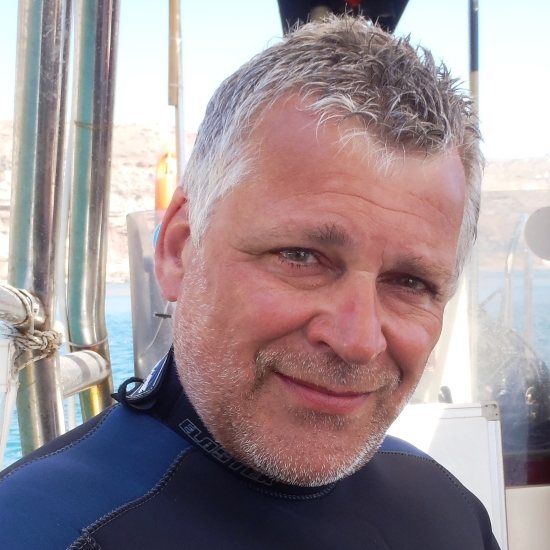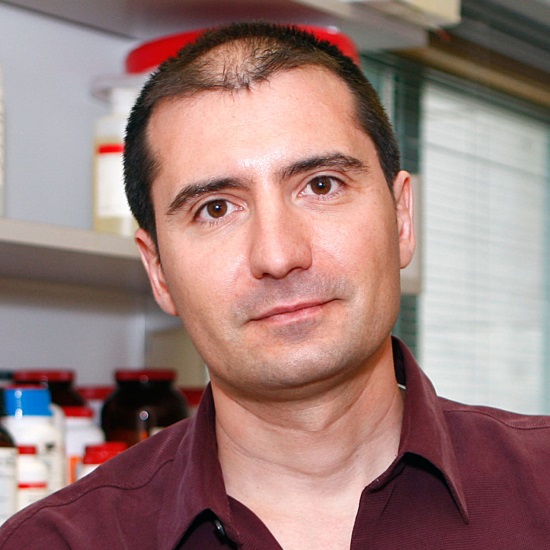Links to external sources may no longer work as intended. The content may not represent the latest thinking in this area or the Society’s current position on the topic.
Evolution and functional biology of neuropeptide signalling: from genomes to behaviour

Theo Murphy international scientific meeting organised by Professor Maurice Elphick, Dr Gáspár Jékely and Professor Lindy Holden-Dye
Neuropeptides are a diverse assemblage of signalling molecules that have key roles in the regulation of behaviour. Understanding the evolutionary relationships and functions of the plethora of neuropeptides has presented a considerable challenge to biologists. This meeting brought together bioinformaticians, structural biologists, neurophysiologists and evolutionary/behavioural biologists to discuss the recent advances that are transforming our knowledge of neuropeptide signalling.
Speaker abstracts and audio recording of the presentations are available below.
Three review articles based on this meeting have now been published: Evolution of neuropeptide signalling systems, The long and the short of it – a perspective on peptidergic regulation of circuits and behaviour and New techniques, applications and perspectives in neuropeptide research.
Attending this event
This event has taken place. Audio recordings of the presentations are available below.
Enquiries: Contact the Scientific Programmes team
Organisers
Schedule
Chair

Dr Gáspár Jékely, Living Systems Institute, University of Exeter, UK

Dr Gáspár Jékely, Living Systems Institute, University of Exeter, UK
Gáspár Jékely studied Biology and obtained his PhD in 1999 at the Eötvös Loránd Universities in Budapest. He then worked as a postdoc at the EMBL, Heidelberg in the laboratory of Pernille Rorth and then Detlev Arendt. Between 2007-2017 he was a group leader at the Max Planck Institute for Developmental Biology in Tübingen, Germany. He moved to the Living Systems Institute at the University of Exeter as Professor of Neuroscience in 2017. His research interests include the structure, function and evolution of neural circuits in marine ciliated larvae and the origin and early evolution of nervous systems.
| 09:00 - 09:40 |
Long-range co-evolution of neuropeptides and their receptors in animals
Neuropeptides and their receptors are a large group of very diverse ligand-receptor molecular systems that are essential for the modulation of the activity of neurons in the brain of animals, and in so doing participate in normal physiology and adaptive behaviour in all animals. Recently a picture has emerged of a core set of neuropeptide/receptor systems that are conserved between species as distant as drosophila, urchin and human. Recently we have identified in the starfish Asterias rubens, a deuterostomian invertebrate from the phylum Echinodermata, a number of neuropeptides that are orthologous to vertebrate neuropeptides that were not known outside of the chordate phylum, including kisspeptins and melanin-concentrating hormones. Interestingly, even in the context of a decentralised, pentaradial body plan, most known vertebrate-type and insect-type neuropeptides are found expressed in neurons of these animals. This work and recent studies in an annelid, Platynereis dumerilii and a nematode, Caenorhabditis elegans indicate that most extant neuropeptides have coevolved with their receptors from their fixation in an ancestor with bilateral symmetry to present-day animals, lending further support to the theory that the urbilaterian was an animal with a sophisticated physiology and nervous system, capable of integrating complex sensory information. Dr Mirabeau will discuss how these homologies can help us gain insights into the fundamental functions of peptidergic systems. 
Dr Olivier Mirabeau, Institut Curie, France

Dr Olivier Mirabeau, Institut Curie, FranceOlivier Mirabeau is a computational biologist working at the Curie Institute in Paris, at the Genetics and Biology of Cancers Unit. He trained as an engineer in Applied Mathematics at the Ecole Centrale in Paris. During his PhD at the European Molecular Biology Laboratory in Monterotondo (Rome) he developed algorithms to predict the existence of novel peptide hormones in the human genome including spexin, and worked on their biochemical characterisation. During his postdoc at the Paris-Saclay Institute of Neuroscience, he studied the evolution of neuropeptides and their receptors and showed that the origin of most human neuropeptides can be traced back to genes that were present in the common ancestor of insects, molluscs, and vertebrates. Since 2014, he has worked as a data scientist at the Curie Institute, France, in a cancer genetics laboratory, and he studies the mechanisms underlying oncogenesis in several paediatric cancer models. |
|
|---|---|---|
| 09:40 - 10:50 |
Evolution of the neuronal secretion apparatus
Calcium-dependent secretion of neurotransmitter-loaded vesicles is at the heart of neuronal communication. The central machine driving the fusion of synaptic vesicles is composed of members of the SNARE protein family. Their assembly into tight membrane-bridging complexes pulls the two membranes together. Their activity is orchestrated by various other factors including Sec1/Munc18 (SM), Rab, and tethering proteins. The key factors involved in neuronal secretion belong to conserved protein families that have similar roles in other intracellular trafficking steps. The group wants to unravel the common mechanism of the machine and how it has adapted to the needs of neuronal secretion during the rise of animals. Our phylogenetic investigations brought to light intriguing expansions of several trafficking factors during the evolutionary transition to animals. The group found an expanded set of SNARE and SM proteins involved in endosomal sorting and an expansion of Ca2+-dependent tethering factors that may have occurred already in unicellular holozoans. In addition, the group observed an expanded set of secretory Rab proteins and factors with C2 domains in early animals. This probably allowed animals to more finely tune the regulation of Ca2+-dependent secretion and also reflects the appearance of specialised cells. 
Dr Dirk Fasshauer, University of Lausanne, Switzerland

Dr Dirk Fasshauer, University of Lausanne, SwitzerlandDirk Fasshauer studied biology and received his doctorate at the University of Göttingen in 1994. He worked as a post-doctoral fellow at the Yale University in New Haven from 1995 to 1997 and moved from there to the Max Planck Institute for Biophysical Chemistry. From 2002, he headed the “Structural Biochemistry” Research Group in the Department of Neurobiology. In 2009, he joined the Department of Fundamental Neurosciences at the University of Lausanne as an associate professor. His group focuses on a structural and functional description of the protein machinery that drives the calcium-dependent release of neurotransmitters from synaptic vesicles. Ultimately, he is interested in the evolutionary development of the machinery, because its core elements are highly conserved among all eukaryotes and throughout the cell. |
|
| 10:15 - 10:50 |
Evolution of the AKH/corazonin/GnRH receptor superfamily in protostomes
Adipokinetic hormone (AKH) is an 8-10 amino acid-long insect neuropeptide hormone that mobilises carbohydrates and lipids from the insect fat body during energy-demanding processes, such as flight and locomotion, but that also is involved in carbohydrate homeostasis. Two structurally related insect neuropeptides are corazonin (apparently involved in stress), and AKH/corazonin-related neuropeptide (ACP; with unknown function). The G protein-coupled receptors (GPCRs) for these three neuropeptides have been cloned and were found also to be closely related, showing a nice example of receptor-ligand co-evolution. In addition and surprisingly, these three receptors are also closely related to the mammalian gonadotropin-releasing hormone (GnRH) receptors, which are involved in reproduction. These findings indicate that GnRH signaling originated very early in evolution before the split of Proto- and Deuterostomia, about 700 MYR ago. In the last few years we have tried to elucidate the evolution of members of the AKH/corazonin/ACP/GnRH receptor superfamily and their ligands in Protostomia. It was found that ACP and ACP receptors were only confined to arthropods and probably represent a ‘recent’ branch of AKH and AKH receptors. AKH and its receptors, at the other hand, do not only occur in insects and other arthropods, but also in nematods (roundworms), priapulids (penis worms), tardigrades (water bears), and molluscs. In the mollusc Crassostrea gigas (Bivalvia) the group found an AKH that completely resembles an insect AKH and we cloned a C. gigas AKH receptor that, when expressed in Chines Hamster Ovary (CHO) cells, becomes strongly activated by nanomolar concentrations of C. gigas AKH. 
Professor Cornelis J.P. Grimmelikhuijzen, University of Copenhagen, Denmark

Professor Cornelis J.P. Grimmelikhuijzen, University of Copenhagen, DenmarkI studied chemistry at the University of Amsterdam (The Netherlands); did a PhD in biochemistry at the University of Amsterdam; then worked as a staff member at the newly founded European Molecular Biology Laboratory in Heidelberg (Germany); and subsequently obtained a 5-year Heisenberg Fellowship to set up my own research group at the Department of Zoology, University of Heidelberg. This stay in Heidelberg was followed by a 6-year stay at the University of Hamburg (Germany), where I was a junior research group leader in the newly founded Center for Molecular Neurobiology. Since 1994, I am professor of molecular neurobiology Head of Cell and Neurobiology at the Department of Biology, University of Copenhagen (Denmark), where I teach mammalian molecular neurobiology. My research, however, is more focused on the molecular neurobiology of invertebrates, mainly arthropods, but also cnidarians and molluscs. |
|
| 11:20 - 11:55 |
The evolution and comparative physiology of neuropeptide signalling: echinoderms as model systems
Advances in genome/transcriptome sequencing have provided opportunities for investigation of neuropeptide signalling in a range of phyla. As deuterostomian invertebrates, echinoderms (sea urchins, starfish) occupy an 'intermediate' phylogenetic position with respect to vertebrates and protostomes and therefore they can provide 'missing links' for reconstruction of neuropeptide evolution. Furthermore, the radial symmetry of echinoderms provides a unique context for exploration of neuropeptide function. Sequencing of the genome of the sea urchin Strongylocentrotus purpuratus identified several novel neuropeptides. Perhaps most remarkable is the neuropeptide NGFFFamide, which is derived from a precursor that contains a neurophysin domain, which hitherto was thought to be unique to vasopressin/oxytocin(VP/OT)-type precursors. Identification of the NGFFFamide receptor as an orthologue of vertebrate neuropeptide-S (NPS)-type receptors and protostome crustacean cardioactive peptide (CCAP)-type receptors facilitated reconstruction of the evolution of the paralogous VP/OT-type and NPS/CCAP-type signaling systems. Sequencing of the neural transcriptome of the starfish Asterias rubens enabled identification of 40 neuropeptide precursors, including 2 precursors of gonadotropin-releasing hormone (GnRH)-like peptides. Identification of the receptors for these peptides revealed that one peptide is the ligand for a GnRH-type receptor, whereas the other is the ligand for a corazonin-type receptor. Hitherto corazonin signalling was thought to be unique to arthropods/protostomes. Discovery of corazonin signalling in an echinoderm has revealed that the evolutionary origin of the paralogous GnRH- and CRZ-type signaling systems dates back to the common ancestor of protostomes and deuterostomes. On-going studies are investigating the physiological roles of neuropeptides in echinoderms, using A. rubens and S. purpuratus as model systems. 
Professor Maurice Elphick, Queen Mary University of London, UK

Professor Maurice Elphick, Queen Mary University of London, UKMaurice Elphick is Professor of Animal Physiology and Neuroscience in the School of Biological and Chemical Sciences at Queen Mary University of London. He was trained in Biology (BSc 1985-1988) at Royal Holloway, University of London and then went on to do a PhD (1988-1991) in neurobiology at Royal Holloway, including a period of research at the University of Florida. After a postdoctoral fellowship at the University of Sussex, he was appointed as a lecturer at Queen Mary in 1995. Maurice pioneered research on neuropeptides in echinoderms, with the discovery of SALMFamides in 1991. After focusing on other neural signalling systems (nitric oxide, endocannabinoids) for many years, he recently returned to the neuropeptide field. Transcriptome/genome sequencing is enabling comprehensive identification of neuropeptides in echinoderms and his research group is using the starfish Asterias rubens as a model deuterostomian invertebrate system to investigate the evolution and comparative physiology of neuropeptide signalling. |
|
| 11:55 - 12:30 |
Neuropeptides and receptors at the dawn of vertebrates: comparisons of cyclostomes and gnathostomes
The gnathostome lineage is now known to have started with a burst of new genes generated by two tetraploidisations resulting in a quadrupled genome. Whether lampreys diverged after the first or the second tetraploidisation is still being discussed. We have deduced the evolution of numerous peptide and receptor families in gnathostomes, including opioid peptides and receptors, NPY peptides and receptors, somatostatin and urotensin II receptors, oxytocin/vasopressin receptors, and CRH/urocortin peptides and receptors. All of these expanded in the two tetraploidizations. However, the corresponding gene families in lampreys have been difficult to resolve due to poor genome assemblies. By analysing gene scaffolds from three lamprey genomes, we have been able to trace conserved synteny that suggests orthology between lamprey and gnathostome genes. For instance, the CRH/urocortin peptide family consists of five members belonging to two subfamilies, one a triplet and one a pair, also in lampreys. Conserved synteny indicates that lampreys and gnathostomes descend from the same double-tetraploid ancestor. Two other peptide families add further support that lampreys share the two tetraploidisations with gnathostomes, namely the NPY and opioid/melanocortin families. Major differences in the nervous system and in overall anatomy show that these two early-diverging vertebrate lineages have experienced dramatically different evolutionary fates after starting from the same quadrupled genome. 
Professor Dan Larhammar, Uppsala University, Sweden

Professor Dan Larhammar, Uppsala University, SwedenDan Larhammar has been professor of molecular cell biology in the Department of Neuroscience at Uppsala University, Uppsala, Sweden since 1994. His research primarily concerns the evolution of vertebrate gene families, especially neuronal and endocrine genes. He also studies the neuropeptide Y family and its receptors that are involved in appetite regulation. This work involves receptor pharmacology and structural modelling as well as human genetic variation. He is active in the debunking of pseudoscience through the Swedish Skeptic Organization. Another interest is neuro-theology. He was made a fellow of the Royal Swedish Academy of Sciences in 2007 and is presently one of its vice presidents. |
Chair

Professor Lindy Holden-Dye, University of Southampton, UK

Professor Lindy Holden-Dye, University of Southampton, UK
Lindy Holden-Dye graduated with a BSc Hons in Physiology from the University of Wales, Cardiff and then moved to the University of Southampton where she studied for a PhD in Neuropharmacology with Professor Geoffrey Woodruff. The expertise at Southampton in invertebrate neuroscience, and her post-doctoral studies with Professor Robert Walker, strongly influenced her career and she has pursued a long-standing interest in using invertebrate systems to provide insight into neural mechanisms of behavioural plasticity, including the pivotal role of neuropeptides. Currently she holds a personal chair in Neuroscience in the Centre for Biological Sciences at the University of Southampton.
| 13:30 - 14:05 |
Robustness and degeneracy in peptide modulation of a central pattern generating circuit
Previous work shows that the crustacean stomatogastric nervous system is modulated by large numbers of small molecule transmitters, amines, and neuropeptides. Moreover, these substances act on each neuron and each synapse within the 26 - 30 neurons of the stomatogastric ganglion. Many of these substances are both circulating neurohormones and are released from the terminals of modulatory projection neurons into the STG neuropil. The big questions that immediately arise are what protects the circuit from ‘over-modulation’, and the role of neuromodulatory control in expanding the output dynamics produced by the central pattern generating circuits or protecting them against environmental perturbation. In this latter context, the group finds that neuromodulators can either make the stomatogastric ganglion motor patterns more or less robust in response to extreme temperature perturbations, depending on the specifics of the currents and target neurons for the modulation. 
Professor Eve Marder, Brandeis University, USA

Professor Eve Marder, Brandeis University, USAEve Marder is the Victor and Gwendolyn Beinfield Professor of Neuroscience in the Biology Department of Brandeis University. Marder was President of the Society for Neuroscience in 2008, and served on the NINDS Council, numerous Study Sections, and a variety of Advisory Boards for institutions in the USA and abroad. Marder is a member of the National Academy of Sciences, the National Academy of Medicine, the American Academy of Arts and Sciences, a Fellow of the Biophysical Society, a Fellow of the American Physiological Society, and a Fellow of the American Association for the Advancement of Science. She received the Miriam Salpeter Memorial Award for Women in Neuroscience, the W.F. Gerard Prize from the Society for Neuroscience, the George A. Miller Award from the Cognitive Neuroscience Society, the Karl Spencer Lashley Prize from the American Philosophical Society, an Honorary Doctorate from Bowdoin College, the Gruber Award in Neuroscience, and the Education Award from the Society for Neuroscience. Marder served on the NIH working group for the Obama BRAIN Initiative. Marder studies the dynamics of small neuronal networks, and her work was instrumental in demonstrating that neuronal circuits are not ‘hard-wired’ but can be reconfigured by neuromodulatory neurons and substances to produce a variety of outputs. For the past 25 years Marder’s lab has combined experimental work with insights from modelling and theoretical studies. Together with Larry Abbott, her lab developed the programmable dynamic clamp, now used widely in laboratories around the world. Her lab pioneered studies of homeostatic regulation of intrinsic membrane properties, and stimulated work on the mechanisms by which brains remain stable while allowing for change during development and learning. Marder is now studying the extent to which similar network performance can arise from different sets of underlying network parameters, opening up rigorous studies of the variations in the individual brains of normal healthy animals. |
|
|---|---|---|
| 14:05 - 14:40 |
Hermaphroditic reproduction and its neuroendocrine modulation
While ultimately the outcome of successful reproduction – fertilisation of eggs and the production of surviving offspring – is relevant for how these processes evolve, a thorough understanding of the underlying, proximate mechanism is essential if one want to interpret evolutionary outcomes properly. Comparing neuroendocrine processes across different species, with different sexual systems, is one way of uncovering similarities and differences in how they have evolved to regulate their reproductive processes. Dr Koene will present experimental work on hermaphroditic snails that will illustrate that it is relevant to consider the mode of sexual system when addressing the neurobiology of reproduction. He will show that, on the one hand, hermaphroditic animals regulate their male and female reproduction via largely non-overlapping neurobiological wiring and neuroendocrine substances, which is not necessarily the case in separate sexed species. On the other hand, because both regulatory systems are present in each individual, this also offers opportunities for ‘hijacking’ their partner’s reproductive system in such a way that their own reproductive success is enhanced. 
Dr Joris M. Koene, Vrije Universiteit, The Netherlands

Dr Joris M. Koene, Vrije Universiteit, The NetherlandsDr Koene was born in Amsterdam, The Netherlands, where he obtained his BSc and MSc in Biology at the Vrije Universiteit. In 1995, he started his PhD at McGill University in Montreal, Canada. After a brief post-doctoral research visit to the Academy of Natural Sciences of Philadelphia, USA, he moved to the Westfaelische Wilhelms-Universitaet in Munster, Germany in 2000. He did a two-year post-doc there, funded by prestigious stipends from the Alexander von Humboldt Foundation and Royal Netherlands Academy of Arts and Sciences. A Dutch career stimulation grant brought him back to Amsterdam, where he has been working and expanding his research group since 2002. He has received several important scientific awards and fellowships, has been (and still is) board member of several scientific societies and is currently Editor-in-Chief of the journal of the Royal Dutch Zoological Society Animal Biology and Associate Editor of Journal of Molluscan Studies. |
|
| 15:10 - 15:45 |
Neuropeptide signalling networks and circuit modulation in C. elegans
Neuropeptides modulate neural circuits controlling adaptive behaviours such as feeding, reproductive behaviours, learning and sensorimotor integration. In C. elegans over 250 neuropeptides have been isolated and predicted, representing the largest group of neuromodulators that can signal extrasynaptically. The defined neural connectome of C. elegans provides the opportunity to generate peptidergic maps and study their modulatory interactions with the synaptic connectome. However, knowledge on neuropeptide receptors is limited, hampering our understanding of general principles in peptidergic modulation. Using reverse pharmacology, the group performed a large-scale deorphanisation screen to identify neuropeptide ligands of C. elegans G protein-coupled receptors (GPCRs). They generated an extensive peptide library including all C. elegans neuropeptides of the RFamide (FLP) and neuropeptide-like (NLP) families, identified by HMM-based prediction tools and peptidomics. This peptide library was used to screen all predicted C. elegans peptide GPCRs in vitro, while receptor activity was measured by calcium mobilisation. This unbiased screening approach sheds light on the diverse RFamide signalling network in C. elegans. These findings support an ancient origin for many peptidergic systems and identify novel orthologues of bilaterian neuropeptide families, including neuropeptide Y and tachykinin signalling systems in C. elegans. Expression and genetic studies of these neuropeptide-receptor pathways indicate conserved modulatory functions in the regulation of locomotion and reproductive behaviours. These results provide a scaffold to further dissect the functions and mechanisms of neuropeptide modulation. 
Dr Isabel Beets, KU Leuven, Belgium; MRC Laboratory of Molecular Biology, UK

Dr Isabel Beets, KU Leuven, Belgium; MRC Laboratory of Molecular Biology, UKMany neuropeptide systems originated early in metazoan evolution and have conserved functions as hormones, but also as modulators of neural circuits and adaptive behaviours. Dr Isabel Beets studied the evolution and functions of oxytocin and vasopressin during her PhD research at KU Leuven (Leuven, Belgium), demonstrating this neuropeptide family has ancient neuromodulatory functions in associative learning circuits. Her recent work has focused on the large-scale deorphanisation of neuropeptide receptors, to characterise the diverse network of peptide-GPCR interactions in C. elegans and their functions in behavioural adaptation. Isabel is currently an EMBO and FWO postdoctoral fellow, working at the MRC Laboratory of Molecular Biology (Cambridge, UK). |
|
| 15:45 - 16:20 |
Combining the connectomics and neuromodulation perspectives in the study of Platynereis larvae
Precise neuronal synaptic connectivity and its modulation by chemical signalling are ultimately responsible for the circuit dynamics controlling effector activity during behaviour. We currently have little information on the complete synaptic connectivity (connectome) of entire neuronal circuits and how these are modulated. The establishment of new, small, relatively simple model organisms could greatly benefit neuroscience by allowing whole-body connectomics and by expanding the range of nervous system phenomena that can be studied. The group works on the larval stages of the marine annelid Platynereis dumerilii that has recently emerged as a powerful experimental system for the study of circuits and their neuromodulation in a whole-body context. They use connectomics, neurogenetics, activity imaging, and behavioural experiments to understand how circuits influence behaviour and physiology in the planktonic larvae of Platynereis. The group mapped the expression of dozens of neuropeptides to the larval connectome using a combination of immunogold labelling and in situ hybridisations. In a large-scale combinatorial screen for peptide receptors, they have also identified receptors for more than 20 neuropeptides in Platynereis. These resources now allow the group to comprehensively address the role of peptidergic signalling in circuits with known connectivity, and how this affects behaviour. By studying different larval stages, it is possible to gain insights into how circuit maturation influences larval behaviour during development. 
Dr Gáspár Jékely, Living Systems Institute, University of Exeter, UK

Dr Gáspár Jékely, Living Systems Institute, University of Exeter, UKGáspár Jékely studied Biology and obtained his PhD in 1999 at the Eötvös Loránd Universities in Budapest. He then worked as a postdoc at the EMBL, Heidelberg in the laboratory of Pernille Rorth and then Detlev Arendt. Between 2007-2017 he was a group leader at the Max Planck Institute for Developmental Biology in Tübingen, Germany. He moved to the Living Systems Institute at the University of Exeter as Professor of Neuroscience in 2017. His research interests include the structure, function and evolution of neural circuits in marine ciliated larvae and the origin and early evolution of nervous systems. |
|
| 16:20 - 17:00 |
Discussion of day 1

Dr Gáspár Jékely, Living Systems Institute, University of Exeter, UK

Dr Gáspár Jékely, Living Systems Institute, University of Exeter, UKGáspár Jékely studied Biology and obtained his PhD in 1999 at the Eötvös Loránd Universities in Budapest. He then worked as a postdoc at the EMBL, Heidelberg in the laboratory of Pernille Rorth and then Detlev Arendt. Between 2007-2017 he was a group leader at the Max Planck Institute for Developmental Biology in Tübingen, Germany. He moved to the Living Systems Institute at the University of Exeter as Professor of Neuroscience in 2017. His research interests include the structure, function and evolution of neural circuits in marine ciliated larvae and the origin and early evolution of nervous systems. 
Professor Lindy Holden-Dye, University of Southampton, UK

Professor Lindy Holden-Dye, University of Southampton, UKLindy Holden-Dye graduated with a BSc Hons in Physiology from the University of Wales, Cardiff and then moved to the University of Southampton where she studied for a PhD in Neuropharmacology with Professor Geoffrey Woodruff. The expertise at Southampton in invertebrate neuroscience, and her post-doctoral studies with Professor Robert Walker, strongly influenced her career and she has pursued a long-standing interest in using invertebrate systems to provide insight into neural mechanisms of behavioural plasticity, including the pivotal role of neuropeptides. Currently she holds a personal chair in Neuroscience in the Centre for Biological Sciences at the University of Southampton. |
Chair

Professor Liliane Schoofs, KU Leuven, Belgium

Professor Liliane Schoofs, KU Leuven, Belgium
Professor Liliane Schoofs is Vice Rector for Research Affairs at KU Leuven. Previously she has been Head of the Functional Genomics and Proteomics Research Unit and Head of Animal Physiology and Neurobiology at KU Leuven. Her research covers the areas of the role of neuropeptides in learning and memory, reproduction in Ecdysozoa, and signal transduction in invertebrate model organisms. Professor Schoofs was elected to the Royal Flemish Academy of Belgium for Science and the Arts in 2010, and sits on the editorial board of the Journal of Insect Biochemistry and Molecular Biology, Physiological Genomics, Frontiers in Neuroscience and PLoS Genetics.
| 09:00 - 09:35 |
Can we unify the endocrinology of ecdysis in arthropods?
Since arthropods have been proposed to share a common crustacean-like ancestor, it is perhaps unsurprising that many neuropeptides, neural networks and signalling pathways involved in the most fundamentally important process in arthropod life history, namely moulting, seem to be common to both insects and crustaceans. Nevertheless, despite the conservation of core mechanisms and networks involved in the act of ecdysis itself- the ‘ecdysis cascade’, that involve hormones such a crustacean cardioactive peptide and bursicon, a somewhat bewildering plethora of other neuropeptides and their cognate receptors exist. These have been revealed by transcriptome mining of insects and de novo assembly of crustacean transcriptomes, including our experimental model, the green shore crab, Carcinus maenas. Many of the peptides and receptors proposed to be involved in ecdysis have undergone neofunctionalisation or gain/loss during evolution. In particular, we still know rather little regarding the identity, distribution and function of crustacean neuropeptide receptors. Here, Professor Webster reviews the current research, highlighting the neuropeptides and receptor signalling that have been identified as involved in crustacean ecdysis, and possible novel roles for neuropeptides first identified in insects. 
Professor Simon Webster, Bangor University, UK

Professor Simon Webster, Bangor University, UKSimon Webster is a professor of arthropod endocrinology at Bangor University. He graduated in Marine Biology (1977) and PhD (1981) from Liverpool University. Subsequently, he undertook postdoctoral research at Bangor (1982-4), Bonn (1884-6; Royal Society European Fellowship), Bangor (1986-90; Royal Society University Research Fellowship), which culminated in the discovery and isolation of the enigmatic and long sought after crustacean moult-inhibiting hormone. Since then, he has continued his research into the hormones and signalling systems involved in ecdysis in crustaceans. |
|
|---|---|---|
| 09:35 - 10:10 |
Neuropeptidergic regulation of zebrafish sleep
Sleep is among the most persistent and perplexing mysteries in biology. However, despite the fact that we devote a third of our lives to sleep, the evolutionary conservation of sleep-like states and the pervasiveness of sleep disorders, mechanisms that regulate sleep remain poorly understood. Sleep has primarily been studied using mammals, where electrophysiology can be used to define sleep and wake states. However, progress has been challenging, due in part to the complexity of mammalian brains and the poor amenability of mammals for large-scale screens. To overcome these limitations, invertebrate sleep models have been established and used to identify neuropeptidergic systems that regulate sleep-like behaviours. However, the utility of these models for understanding mammalian sleep may ultimately be limited because invertebrate brains bear little anatomical or molecular resemblance to mammalian brains, and many of the genes identified in invertebrates lack obvious vertebrate orthologues. Conversely, most neuropeptides implicated in regulating mammalian sleep lack clear invertebrate orthologues. As an alternative approach, Dr Prober’s lab is using the zebrafish, a diurnal vertebrate that combines advantages of mammalian and invertebrate models, to explore genetic and neuronal mechanisms that regulate sleep. Dr Prober will describe our use of genetic screens and candidate-gene based approaches to identify neuropeptidergic systems that regulate sleep in zebrafish, including systems that appear to be conserved with invertebrates. 
Dr David Prober, California Institute of Technology, USA

Dr David Prober, California Institute of Technology, USADr Prober received his doctorate in molecular and cellular biology from the University of Washington in 2002. Following post-doctoral training at New York University and Harvard University, he joined the faculty at the California Institute of Technology as an assistant professor in 2009, and was promoted to professor in 2017. Dr Prober is the grateful recipient of several awards, including a NARSAD Young Investigator Award, an NIH Pathway to Independence Award and a Sleep Research Society Young Investigator Award. Dr Prober’s research has been supported by grants from the Rita Allen Foundation, the Edward Mallinckrodt Jr. Foundation, the Della Martin Fund, Sanofi-Aventis and the National Institutes of Health. Dr Prober and his colleagues established the zebrafish as a vertebrate model system to study sleep, and have exploited advantageous features of this model to identify several neuropeptidergic systems that regulate sleep. |
|
| 10:10 - 10:45 |
Neuroendocrine control of environmental stress responses
Insects are exposed to a continuous multiple stressors across a range of environments. Desiccation tolerance and survival is dependent on fluid homeostasis by fluid transporting epithelia including the Malpighian tubules. Fluid transport by insect Malpighian tubules is modulated by diuretic neuropeptides which have also recently been shown to affect desiccation and starvation tolerance in the insect genetic model Drosophila melanogaster. However, in addition to this, a novel role for Malpighian tubules in cold tolerance has been recently demonstrated, which occurs via homeostatic control of water and ion balance and is modulated by the capa neuropeptide. Altogether, this current evidence suggests that at least three diuretic neuropeptides (capa, DH44, kinin) perform functions in environmental stress tolerance via the Malpighian tubules. Thus, Malpighian tubules, and diuretic neuropeptides, have much wider implications for physiology and behaviour beyond osmoregulation. 
Professor Shireen Davies, University of Glasgow, UK

Professor Shireen Davies, University of Glasgow, UKShireen Davies is Professor of Integrative Cell Signalling at the Institute of Molecular Cell and Systems Biology, University of Glasgow. She was born in Singapore and gained Biochemistry degrees from the Universities of Aberdeen (BSc, Hons) and Glasgow (PhD). She has worked on neuropeptides, cell signalling and ion transport in epithelial function and is now interested in how organisms tolerate and survive environmental stress, in particular, the key roles that peptide hormones (neuropeptides) play in stress survival. She uses the model insect Drosophila melanogaster to investigate these questions from the molecule to whole organism and species; and also works on insect pest species. Other work is focussed on Drosophila models of renal disease. Shireen’s research is funded by the UK Biotechnology and Biological Sciences Research Council and by the European Commission. She is also the Coordinator of the nEUROSTRESSPEP programme, which aims to develop novel neuroendocrinology-based pest insect biocontrol. |
|
| 11:15 - 11:50 |
Interleukin 17 as a modulator of neural circuit output and behaviour
The immune system and nervous system interact in ways that are only just beginning to be elucidated. Emerging data point to the inflammatory response being a contributor to depression and schizophrenia. Interleukin-17 (IL-17) is a major pro-inflammatory cytokine: it mediates responses to pathogens or tissue damage, and drives autoimmune diseases. Little is known about its role in the nervous system. Dr de Bono will describe experiments showing that IL-17 has neuromodulator-like properties in Caenorhabditis elegans. IL-17 can act directly on neurons to alter their response properties and contribution to behaviour. Using unbiased genetic screens, the group delineates an IL-17 signalling pathway. They show that IL-17 receptors and downstream signalling components are expressed widely in the nervous system. Dr de Bono will show how IL-17 signalling changes the properties of a tonic circuit that enables C. elegans to presistently escape 21% oxygen (O2). In this animal 21% O2 serves as a toxin of surface exposure and reprograms global animal state. IL-17 alters the properties of the RMG hub interneurons, which are connected to sensory neurons that detect O2, pheromones, noxious cues and mechanical cues. Disrupting IL-17 signalling reduces RMG responsiveness to input from O2 and pheromone sensors, and renders sustained escape from 21% O2 transient and contingent on additional stimuli. Conversely, overactivating IL-17 receptors abnormally heightens responses to 21% O2 in RMG neurons and whole animals. IL-17 deficiency can be bypassed by optogenetic stimulation of RMG. Inducing IL-17 expression in adults can rescue mutant defects within 6 h. These findings reveal a non-immunological role of IL-17 modulating circuit function and behaviour. 
Dr Mario de Bono, MRC Laboratory of Molecular Biology, UK

Dr Mario de Bono, MRC Laboratory of Molecular Biology, UKI work at the interface of neuroscience and cell biology. My lab seeks to understand how genes encode the signalling properties of identified neurons, and how these neurons function in circuits to generate behaviour. Much of the work uses the C. elegans model. The group integrates data from multiple approaches – genetics, genomics, neural imaging, cell biology, biochemistry and behavioural analysis. A substantial subset of the molecules identified using forward genetic screens for behavioural mutants are conserved and have poorly understood functions. To extend our work to vertebrates, we are beginning to study mouse/ human orthologs of gene complexes we identified in worm. |
|
| 11:50 - 12:25 |
Neuropeptidergic modulation of chemosensory processing and decision making in Drosophila
Animals have to make decisions many times per day. These decisions include decisions about where and how to find optimal food sources while avoiding toxic foods or predators. The decisions and behaviours, however, need to be flexible to meet individual needs and particular circumstances. For instance, metabolic states largely influence an animal’s interest in food in general, but also for specific nutrients. How gravid females identify foods to match their specific dietary needs remains elusive. Among these needs are pungent smelling polyamines, such as putrescine and spermidine, which are essential for cell proliferation, reproduction, and embryonic development in all animals. Using Drosophila, the group have identified a behavioural, neuronal, and genetic mechanism that adapts the senses of smell and taste, the major modalities for food quality, to the physiological needs of a gravid female. The group shows that female flies seek fermenting fruit, which are rich in polyamines, through specific olfactory and gustatory ionotropic receptors (IRs) and bitter taste neurons. Polyamine attraction is enhanced in a sex-specific manner in gravid females through a G-protein coupled receptor and its neuropeptide ligands that act directly in the polyamine-detecting chemosensory neurons. Together, these data show that neuropeptide-mediated modulation of chemosensory neurons increases pregnant females’ preference for important nutrients to ensure optimal conditions for her growing progeny. 
Dr Ilona Grunwald Kadow, Max Planck Institute of Neurobiology, Germany

Dr Ilona Grunwald Kadow, Max Planck Institute of Neurobiology, GermanyIlona Grunwald Kadow received her doctorate in 2002 from the EMBL and University of Heidelberg, where she worked in the lab of Professor Rüdiger Klein on the molecular mechanisms underlying learning and memory in the mouse. She then moved to the laboratory of Professor Larry Zipursky at HHMI/UC Los Angeles to work on synapse formation in the fly. Since the end of 2008, Dr Grunwald Kadow has run her own lab at the Max-Planck Institute of Neurobiology, Martinsried, Germany focussing on the neuronal and genetic mechanisms underpinning context-specific decision-making. In particular, her lab studies internal state-dependent processing of chemosensory stimuli – odours and tastes. Dr Grunwald received the HFSP career development award, the EMBO Young Investigator award, and an ERC starting grant for her work. |
Chair

Professor Maurice Elphick, Queen Mary University of London, UK

Professor Maurice Elphick, Queen Mary University of London, UK
Maurice Elphick is Professor of Animal Physiology and Neuroscience in the School of Biological and Chemical Sciences at Queen Mary University of London. He was trained in Biology (BSc 1985-1988) at Royal Holloway, University of London and then went on to do a PhD (1988-1991) in neurobiology at Royal Holloway, including a period of research at the University of Florida. After a postdoctoral fellowship at the University of Sussex, he was appointed as a lecturer at Queen Mary in 1995. Maurice pioneered research on neuropeptides in echinoderms, with the discovery of SALMFamides in 1991. After focusing on other neural signalling systems (nitric oxide, endocannabinoids) for many years, he recently returned to the neuropeptide field. Transcriptome/genome sequencing is enabling comprehensive identification of neuropeptides in echinoderms and his research group is using the starfish Asterias rubens as a model deuterostomian invertebrate system to investigate the evolution and comparative physiology of neuropeptide signalling.
| 13:25 - 14:00 |
Deciphering neuropeptide signalling via mass spectrometry-based peptidomic approaches: from discovery to function
All nervous systems employ a large number of amines, amino acids and neuropeptides as neurotransmitters and neuromodulators. Comprehensive characterisation of all signalling molecules in a nervous system with chemical, spatial and temporal information is often critical to deciphering the functionality of a neural circuit yet it presents a daunting challenge. The group has chosen to work with a simpler and well-defined crustacean nervous system to both facilitate technology development and address fundamental neuroscience problems related to neuromodulation and network plasticity. In this talk, Professor Li will present the progress on the development of a multi-faceted mass spectrometry-based analytical platform to probe neuronal signalling with enhanced sensitivity and selectivity. By combining chemical labelling, micro-scale separation, and tandem mass spectrometry sequencing techniques, the group has discovered a large number of novel neuropeptides in crustacean nervous systems. Moreover, both mass spectrometric imaging technology and in vivo microdialysis sampling tools have been developed and implemented to follow neuropeptide spatial distribution, dynamic secretion, and sequential degradation with unprecedented details. Furthermore, isotopic and novel tandem mass tagging reagents based on dimethylated amino acids have been developed and employed to produce differential display of neuropeptidomes under different physiological conditions. Examples of neuropeptide regulation of feeding behaviour, environmental stress, and neural network development will be highlighted. Collectively, these combined studies will help elucidate the functional roles that neuropeptides play in regulating neural plasticity as well as the functional consequences of neuropeptide diversity and multiplicity. 
Professor Lingjun Li, University of Wisconsin-Madison, USA

Professor Lingjun Li, University of Wisconsin-Madison, USALingjun Li, PhD, is a Vilas Distinguished Achievement Professor and Janis Apinis Professor of Pharmaceutical Sciences and Chemistry at the University of Wisconsin-Madison. She received her B.E. degree in Environmental Analytical Chemistry from Beijing University of Technology in China, and her PhD in Analytical Chemistry from the University of Illinois at Urbana-Champaign in USA. Her lab focuses on the development and application of novel mass spectrometry (MS)-based tools for functional discovery of neuropeptides and protein biomarkers in neurodegenerative diseases. Professor Li and her group discovered more than 300 novel neuropeptides in various model organisms. These findings significantly expanded our knowledge about neuropeptides in these important model organisms and transformed our current understanding of neuropeptide family organisation. Professor Li has published over 190 peer-reviewed papers (H-index 51), and received numerous awards including American Society for Mass Spectrometry (ASMS) Research Award, NSF CAREER Award, Sloan Fellowship, 2011 PittCon Achievement Award, and 2014 ASMS Biemann Medal. |
|
|---|---|---|
| 14:00 - 14:35 |
Regulation of synaptic transmission by peptides in cortex and striatum
Neurons within the mouse brain are often categorised by the patterns of expression of neuropeptides and their receptors. Here the group described the function of neuropeptides in regulating synapse and circuit function in two parts of the mouse brain. First, within striatum Enkephalin is produced by neurons of the indirect pathway and detected by neurons of multiple classes that express mu and delta opioid receptors. The group finds that Enk, acting primarily via delta receptors, inhibits GABAergic synapses that connect the indirect and direct pathway striatal projection neurons to facilitate the latter pro-kinetic pathway. This effect is limited to synapses found within the ‘patch/striosome’ sub-compartment of the striatum. Second, the group discovers an intracortical system by which a peptide made by cortical pyramidal cells acts on cortical Vip interneurons to disinhibit cortical activity and promote cortical plasticity. In summary, this work demonstrates multiple pathways by which peptide based signalling regulates the efficacy of traditional fast-neurotransmitter based intra-cellular signalling. 
Professor Bernardo L. Sabatini, Harvard Medical School, USA

Professor Bernardo L. Sabatini, Harvard Medical School, USABernardo Sabatini obtained a PhD from the Department of Neurobiology and his MD degree from the Harvard/Massachusetts Institute of Technology Program in Health Sciences and Technology in 1999. Dr Sabatini chose to not pursue further medical training, and instead began a postdoctoral fellowship in the laboratory of Dr Karel Svoboda at Cold Spring Harbor Laboratory in New York. After his postdoctoral research, Dr Sabatini joined the faculty in the Department of Neurobiology at Harvard Medical School in 2001. In 2008 Dr Sabatini was named an investigator of the Howard Hughes Medical Institute and in 2010 was named the Takeda Professor of Neurobiology at Harvard Medical School. His laboratory seeks to uncover the mechanisms of synapse and circuit plasticity that permit new behaviours to be learned and refined. They are interested in the developmental changes that occur after birth that make learning possible, as well as in the circuit changes that are triggered by the process of learning. Lastly, they examine how perturbations of these processes contribute to human neuropsychiatric disorders such as Tuberous Sclerosis Complex and Parkinson’s disease. In order to conduct their studies, Dr Sabatini’s laboratory creates new optical and chemical methods to be able to observe and manipulate the biochemical signalling associated with synapse function. In 2014 Dr Sabatini was elected to the American Academy of Arts and Sciences, and was also the recipient of the 2013-2014 A. Clifford Barger Excellence in Mentoring Award. He serves on a number of scientific advisory boards including the Simons Center for the Global Brain, the Max Planck Florida Institute, and others both domestically and abroad. Dr Sabatini is currently the Alice and Rodman W. Moorhead III Professor of Neurobiology at HMS. He lives in Newton with his wife, who is a physician at MGH, and their three boys. |
|
| 15:00 - 15:35 |
Structural biology of opioid receptors
Opioid receptors (OR), members of the G protein-coupled receptor (GPCR) superfamily, constitute the major and the most effective target for the treatment of pain. µ-opioid receptors (µOR) are activated by a structurally diverse spectrum of natural and synthetic agonists including endogenous endorphin peptides, morphine and methadone. The recent structures of the µOR in inactive and agonist-induced active states provide snapshots of the receptor at the beginning and end of a signalling event. The group used solution-state NMR to examine the process of µOR activation. These results suggest a weak allosteric coupling between the agonist-binding pocket and G-protein-coupling interface (transmembrane TM 5 and 6). Furthermore, the analysis provides clues on the successive structural events leading to the full active conformation of µOR. However, much remains to be learned about the mechanisms by which different agonists can induce distinct levels of G-protein activation and/or arrestin recruitment upon activation of µOR. In this study, the group are investigating the conformational landscape of the µOR in distinct pharmacological conditions using liquid-state NMR spectroscopy and advanced pharmacology signalling characterisation. In particular, the group have developed a double labelling scheme to monitor signals from distinct methyl probes in specifically labelled µOR domains. And In combination, the group assesses the potential for biased agonism to activate different cell signalling pathways, such as G-proteins activation, β-arrestins recruitment and µOR trafficking. The goal is to provide a mechanistic understanding of opioid receptor activation upon binding of ligands presenting distinct efficacy and/or biased signalling properties. A better knowledge of the structural basis for opioid drug efficacy may lead to new therapeutic approaches with limited side effects. 
Dr Sébastien Granier, INSERM-Institut de Génomique Fonctionnelle Montpellier, France

Dr Sébastien Granier, INSERM-Institut de Génomique Fonctionnelle Montpellier, FranceSébastien Granier, PhD, has a broad background in G protein-coupled receptors (GPCRs) biochemistry and structural biology. He has studied these proteins since the beginning of his career applying a wide variety of biophysical approaches to address important questions regarding GPCRs function. As a postdoctoral fellow at Stanford in the laboratory of Professor Brian Kobilka, he started to study opioid receptors which are one of the most studied GPCR representing an ideal target to treat pain and neurological dysfunctions. At that time he has developed tools to express and purify ORs to enable structural studies. After his post-doc, he obtained a tenure track position in France where he has developed biophysical approaches to study vasopressin V2 and glutamate receptors. After 3 years, he decided to go back to Stanford in the Kobilka Lab as a visiting scientist during two years expanding his research to high-resolution structural studies of OR and V2R using X-ray crystallography. He is now a group leader in Montpellier University and is pursuing his work on deciphering the activation mechanisms of GPCR and other membrane proteins. |
|
| 15:35 - 16:10 |
Alternative receptors for neuropeptides - ion channels!
Chemical synapses use small molecule transmitters and neuropeptides for transmission. It is textbook knowledge that only small molecule neurotransmitters directly gate ion channels, mediating fast neurotransmission, whereas neuropeptides activate exclusively G-protein coupled receptors, mediating slow neurotransmission. The first exception to this rule was the FMRFamide-activated Na+ channel (FaNaC), which is directly activated by the evolutionary old neuropeptide FMRFamide. So far, FaNaC has been cloned exclusively from different molluscs, which belong to the clade of protostomes (Bilateria). A sister group to Bilateria are Cnidaria, animals with a simple body plan. The group used a model Cnidarian, the freshwater polyp Hydra, to clone and functionally characterise ion channels that are related to FaNaC and directly gated by neuropeptides, the Hydra Na+ channels (HyNaCs). The Hydra genome contains genes encoding 12 HyNaCs that assemble into different heterotrimeric ion channels, which are directly activated by RFamide-neuropeptides of the Hydra nervous system. HyNaCs are expressed by epitheliomuscular cells at the base of the tentacles or the foot region, suggesting that the simple nervous system of Hydra extensively uses neuropeptides for fast neurotransmission, perhaps for neuromuscular transmission. The presence of related peptide-gated channels in Cnidaria and Bilateria suggests that peptide-gated channels have a deep evolutionary origin. Recently, the group cloned another peptide-gated channel, closely related to FaNaC, from the marine annelid worm Platynereis, which is directly activated by a neuropeptide that is not a RFamide. These results suggest that peptide-gated channels may be present in many animals and activated by a range of chemically diverse neuropeptides. 
Professor Stefan Gründer, Institute of Physiology, RWTH Aachen University, Germany

Professor Stefan Gründer, Institute of Physiology, RWTH Aachen University, GermanyDr Stefan Gründer is Professor and Director of the Institute of Physiology of RWTH Aachen University. He currently is dean of studies of the Medical School of RWTH Aachen University. After his studies of biology at the University of Cologne in 1989, he did a PhD in the group of Thomas J. Jentsch at Hamburg University (1990-1993) and then joined the group of Bernard C. Rossier at the University of Lausanne in Switzerland as a Post-Doc (1993-1997). He then moved to Tübingen, Germany, where he joined the group of Peter Ruppersberg at the Institute of Physiology, where he did his 'habilitation (venia legendi)' in Physiology (2003). In 2004 he became Associate Professor of Physiology at the University of Würzburg. In 2008 he was appointed Full Professor of Physiology at RWTH Aachen University and since then directs its Institute of Physiology. |
|
| 16:10 - 16:45 |
The development of Functional Genomics Platforms for nematode pathogens: informing the biology of neuropeptides and their receptors
Traditional approaches to the discovery, localisation and functional characterisation of nematode neuropeptides have included immunocytochemical techniques, classical biochemical characterisation methods, PCR-based gene detection tools, and muscle-based physiology assays. The data generated highlighted the importance of neuropeptides to nematode biology, and flagged the candidature of the neuropeptidergic system as a putative anthelmintic target. More recently, these datasets have been enhanced by the omic-analyses of nematode genome, transcriptome and peptidome datasets enabling the identification and prioritisation of neuropeptides and their receptors that exhibit therapeutic appeal, but are not yet validated. Unfortunately, the development of functional biology tools in nematode parasites has not kept pace. Indeed, a key hurdle to the exploitation of putative targets is the absence of tools that allow the elucidation of target function in therapeutically-relevant nematode pathogens. Broadly, reverse genetics is being applied to probe the biology of many organisms through sophisticated methods of transgenesis, gene silencing (RNA interference), and genome editing (CRISPR/Cas9 technology). The application of these experimental tools to nematode parasites has been eagerly awaited; however their translation has either been difficult or is in early stages of development, such that their impact on novel drug discovery for the control of nematode pathogens is yet to be realised. This presentation provides an overview of Functional Genomics Platforms that are currently available for use in parasitic nematodes, and describes progress in their application to the understanding of the neuropeptidergic system. 
Dr Angela Mousley, Queen's University Belfast, UK

Dr Angela Mousley, Queen's University Belfast, UKDr Angela Mousley is a Senior Lecturer in Molecular Parasitology at Queen’s University Belfast. She obtained a PhD from QUB in 2001 and was a Post-Doctoral Research Assistant (2001-06) before being appointed as a Lecturer in 2007. Angela’s research interests relate to the neurobiology of helminth parasites, including the identification and validation of neuronal drug target candidates particularly those associated with neuropeptide signalling. Her current research efforts focus on implementing reverse genetics (RNA interference) platforms to probe neuropeptide gene function in parasitic nematodes, and facilitate comparative functional analyses. In addition, she is interested in employing RNAi technologies in parasitic nematodes as a route to in vivo receptor deorphanisation. She has >30 published articles in helminth neurobiology, and she has written invited reviews and delivered invited speaker presentations at international conferences. She has been an active member of the British Society for Parasitology (BSP) since 1998, and was the Honorary Treasurer for the society (2010-2013).
|
|
| 16:45 - 17:30 |
Discussion of day 2 and closing remarks

Professor Maurice Elphick, Queen Mary University of London, UK

Professor Maurice Elphick, Queen Mary University of London, UKMaurice Elphick is Professor of Animal Physiology and Neuroscience in the School of Biological and Chemical Sciences at Queen Mary University of London. He was trained in Biology (BSc 1985-1988) at Royal Holloway, University of London and then went on to do a PhD (1988-1991) in neurobiology at Royal Holloway, including a period of research at the University of Florida. After a postdoctoral fellowship at the University of Sussex, he was appointed as a lecturer at Queen Mary in 1995. Maurice pioneered research on neuropeptides in echinoderms, with the discovery of SALMFamides in 1991. After focusing on other neural signalling systems (nitric oxide, endocannabinoids) for many years, he recently returned to the neuropeptide field. Transcriptome/genome sequencing is enabling comprehensive identification of neuropeptides in echinoderms and his research group is using the starfish Asterias rubens as a model deuterostomian invertebrate system to investigate the evolution and comparative physiology of neuropeptide signalling. |
